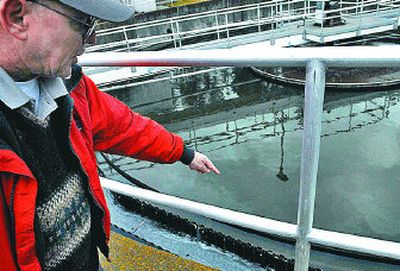New sewage rules among nation’s toughest

Sewage treatment plants in Coeur d’Alene, Post Falls and Hayden are facing some of the strictest water quality standards in the nation under new requirements proposed Thursday by the federal government.
For just the city of Coeur d’Alene, meeting the new super-squeaky-clean standard will require “the most advanced treatment plant in the world,” expected to cost between $30 million and $60 million, said Wastewater Superintendent Sid Fredrickson.
“If it’s in the permit, there isn’t any negotiation,” Fredrickson said of meeting the new standards. “We will have to, period.”
Although the price is a bit shocking, the changes aren’t a surprise, Fredrickson said. Cities along the river have been working with federal and state agencies since 2005 to set the standards.
The city of Coeur d’Alene has not yet determined how much this will cost ratepayers. Estimates should be available later this year, Fredrickson said.
The tighter purity standards are part of a massive effort to reduce phosphorus levels in the Spokane River. Phosphorus leads to algae blooms downstream in Long Lake, a Spokane River reservoir sometimes called Lake Spokane. The blooms end up sucking much of the oxygen out of the lake, creating large dead zones where no fish or insects can live.
Tighter standards are also coming this spring for cities and wastewater dischargers along the Spokane River in Washington. The changes will be phased in over the next decade to give the cities time to add the technology needed to clean the water.
Spokane County officials are formulating plans to build a new wastewater plant they hope will be operating by 2012. They say the plant likely will be one of the most advanced in the country for removing phosphorus and will meet new pollution requirements that the county agreed to last year.
“We hope to see marked improvements in water quality in Lake Spokane when all this is done,” said Tim Eaton, director of operations for the Washington office of the U.S. Environmental Protection Agency.
Currently, the wastewater discharged by Coeur d’Alene into the Spokane River contains an average of 890 parts of phosphorus per 1 billion parts of water. This represents an 88 percent cleanup from the raw sewage that comes into the plant, Fredrickson said.
Under the proposed new EPA standards, Coeur d’Alene, Post Falls and Hayden would be allowed to discharge only 50 parts per billion from June through September, when the river is at its lowest. More phosphorus will be allowed into the river when the water is higher.
Although the standard is likely the most stringent in the nation, it might not be clean enough to meet federal water quality requirements for Long Lake, said Rick Eichstaedt, an environmental attorney for the Center For Justice in Spokane. Eichstaedt, who has closely followed the issue, said a standard of 10 parts per billion is needed for all dischargers on the Spokane River in order to meet the water quality standards for Long Lake.
If the three Idaho cities were the only wastewater plants discharging to the river, 50 parts per billion would be acceptable, Eichstaedt said. But these cities contribute less than 10 percent of the total phosphorus in the river. Eichstaedt said the EPA’s standards for Idaho will make it even tougher for Spokane and Liberty Lake to meet water quality standards.
The EPA is “ignoring what’s coming into the river from Washington,” he said.
The permits are only in draft form, but if the standards remain the same, the water in Long Lake will not be clean enough to meet water quality laws, Eichstaedt said.
He acknowledged that 10 parts per billion appears to be nearly impossible to reach with current technology, but said the EPA should set the bar at the level needed to meet the law.
“You don’t get credit for being close. It’s not horseshoes. You need to get right on target,” Eichstaedt said.
EPA officials say the water from Idaho will meet Washington’s water quality standards once it flows over the state line.
Jani Gilbert, spokeswoman for the Washington Department of Ecology, said Washington eventually hopes to set the standard at 10 parts per billion, but it could take another decade or two. She said the state is considering the entire river in designing its wastewater permits.
When asked whether Idaho’s standard takes away flexibility for Washington, Gilbert replied, “That is an issue that has been hotly discussed. … We believe there is some room left for Washington.”